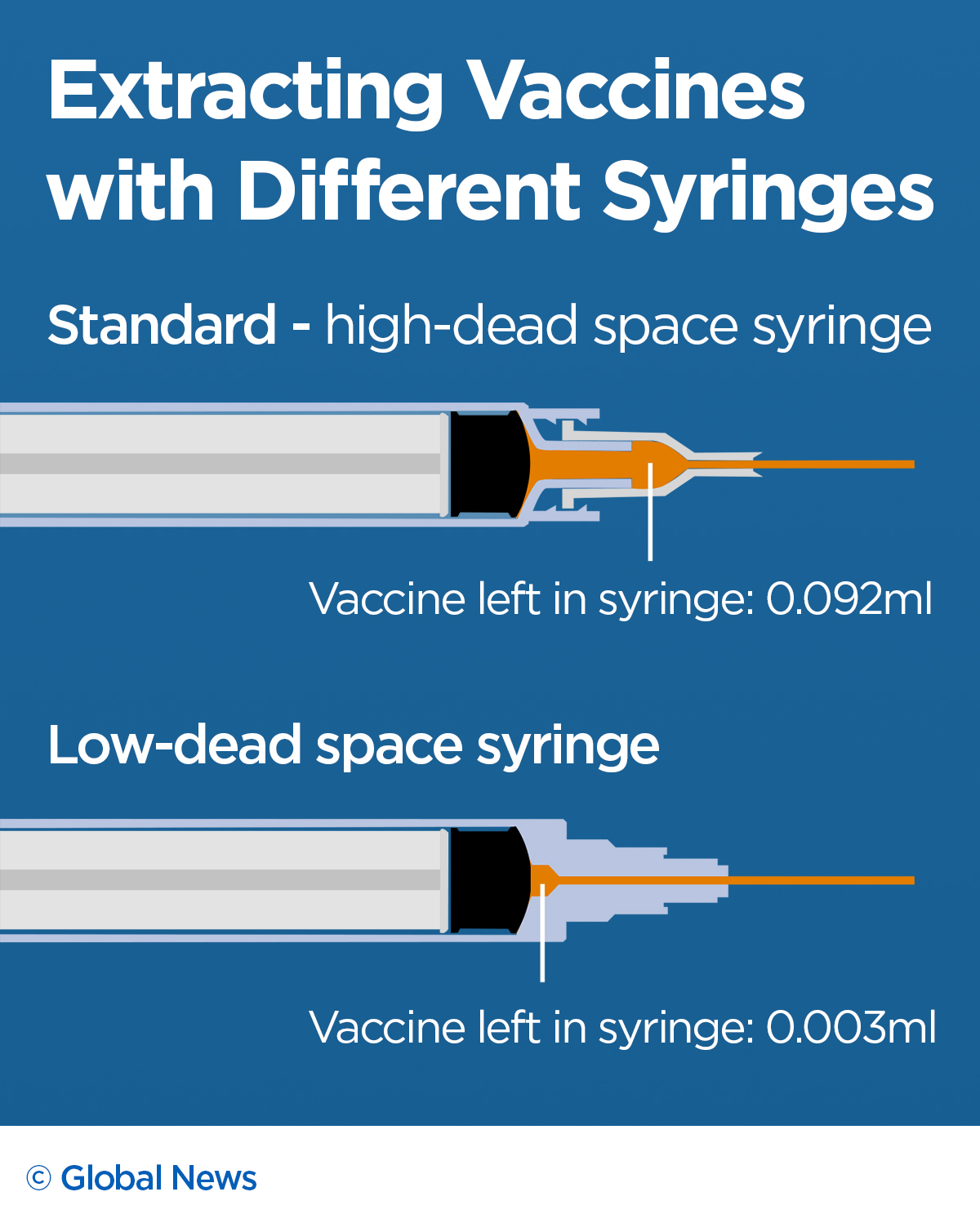What may seem like a small change, could make a big impact.

Health Canada’s approval to get six doses instead of five from Pfizer-BioNTech’s coronavirus vaccine vials has been touted as a way to make the precious drug go even further as the country fumbles with a widespread rollout.
But the regulatory approval has collided with two key concerns: securing the proper equipment to do the job and training vaccinators on how to extract all six does reliably and consistently.
“There’s a whole separate side to this beyond the actual vaccine itself,” Kelly Grindrod, a professor at the University of Waterloo’s School of Pharmacy, previously told Global News.
Here’s what Canada’s doing to (hopefully) solve both:
Equipment needs
Like all liquid vaccines, each Pfizer vial contains more than the amount displayed on the label — called “overfill” to ensure there is sufficient vaccine in each vial to get the expected doses.
- Canadian woman charged with illegally crossing into U.S., kicking border agent’s face
- A new ‘cold’ war? Canada looks to bolster Arctic security, sovereignty
- Canadian furniture industry still ‘reeling’ after Trump pauses tariff spike
- Ottawa propose fines of up to $1M for violating foreign influence registry rules
That extra liquid acts as a buffer and to account for possible waste during vaccination.
But, with the use of special syringes, Health Canada agreed Tuesday that six full doses can be extracted consistently from the Pfizer vials.
These syringes — called low-dead-space syringes — can minimize waste by eliminating gaps between the plunger and needle. These syringes allow the user to push virtually all fluid out of the syringe chamber.
Securing enough of these special syringes will be key for Canada’s vaccination campaign, which is expected to ramp up next week.
Canada’s vaccination plans rely heavily on Pfizer’s vaccine. It makes up two-thirds of the country’s Q1 supply with a total of four million doses expected. With the label change, Canada will receive fewer vials but expects to extract the same number of doses.
To coincide with the label change, Health Canada says it has ordered 64 million of the syringes, and deliveries began last week. Procurement Minister Anita Anand says the deliveries will continue through May.
The syringes are being tested now to make sure they meet standards.
Unfortunately, Canada is late to the global syringe race.

Get weekly health news
The U.S. already amended its contract with Pfizer to reflect the label change on Jan. 6. The European Union did the same two days later.
Health experts in both have expressed concerns about scaling up the production and procurement of these syringes to meet the global vaccination program.

With the headache of procuring enough personal protective equipment (PPE) still fresh in the minds of many Canadians, experts here are similarly concerned.
Most countries, including Canada, don’t have stockpiles of these needles.
They’re often used for expensive medicines where governments and patients want to keep costs low, Grindrod told The Canadian Press previously.
Shortages could become a problem as suppliers scramble to meet widespread demand. One medical device manufacturer, Dickinson and Company, described the products as “niche” and said that, up until now, there has been “minimal market demand.”
Just last month in the U.S., the Department of Health and Human Services warned the FDA about a potential long-term shortage of the special syringes. There are also reports of millions of Pfizer vaccine doses going to waste in Japan because of a shortage of these syringes.
Then there’s the “human aspect” of green-lighting a six-dose regimen, as Dr. Howard Njoo, Canada’s deputy chief public health officer said on Feb. 2.
“It’s not easy.”
‘Human’ aspect
Even with the specialized syringes, some provinces are reporting a problem drawing the sixth dose consistently.
Some experts in British Columbia estimate that the sixth dose can only be drawn about half the time.

Alberta has made similar complaints.
Health Canada said Pfizer’s data clearly demonstrated that six doses could be extracted from each vial using the syringes — so long as those syringes were used with “good technique.”
It requires a “certain level of experience,” Njoo said in the past.
As part of the deal, the company must provide educational support to provinces. Training will be provided this week via webinar to help guide medical professionals on how to get the sixth dose.
Even then, it’s not fool-proof, said Grindrod.
She said even with the best supplies and training, there’s no guarantee a sixth dose can be squeezed from the single vial.
Hospital pharmacy programs are finding the extra dose is available eight times out of 10, she added.

However, Grindrod suggested that the rate will fall when vaccination widens and nurses or doctors currently who are less accustomed to giving inoculations are on duty.
“These folks are used to multi-dose vials because flu shots often come as multi-dose vials, but maybe they’re not drawing many like that other than flu shots for a few months a year,” she told The Canadian Press.
“It’s not like they’re in the pharmacy doing hundreds of these every day, like technicians might be.”
Some experts say this issue could have been better anticipated.
Jesse Goodman, a former chief scientist at the FDA and the director of Georgetown University’s Center on Medical Product Access, Safety and Stewardship, said health providers in many countries were able to extract extra doses from vials during the H1N1 pandemic in 2009.
It was a known strategy to help stretch supplies, according to Goodman.
“It’s one more thing that was lost in the woodwork during the vaccine response,” he told the Washington Post on Feb. 3.
“If this problem had been identified and surfaced as part of the planning effort for vaccination, rather than suddenly ramping up production of these things in the last month, this is something that could have been done six months ago.”
–With files from The Canadian Press and Global News staff










Comments